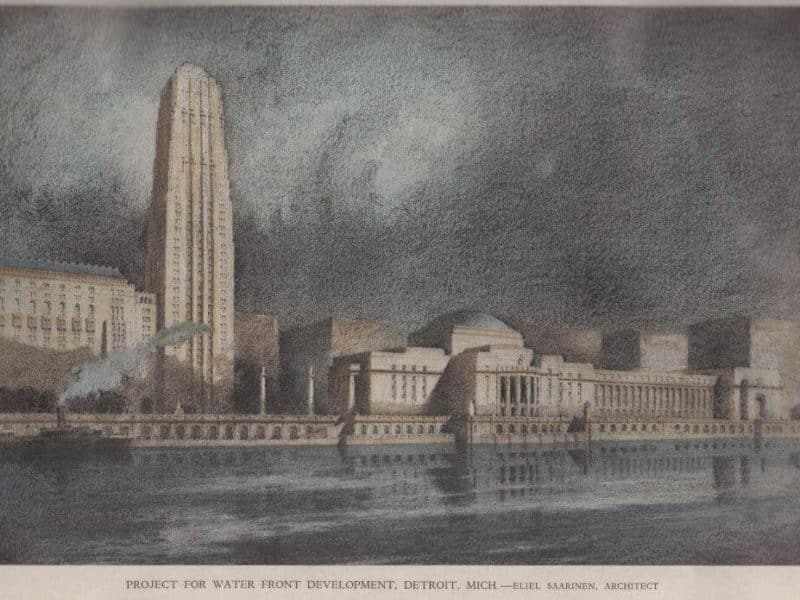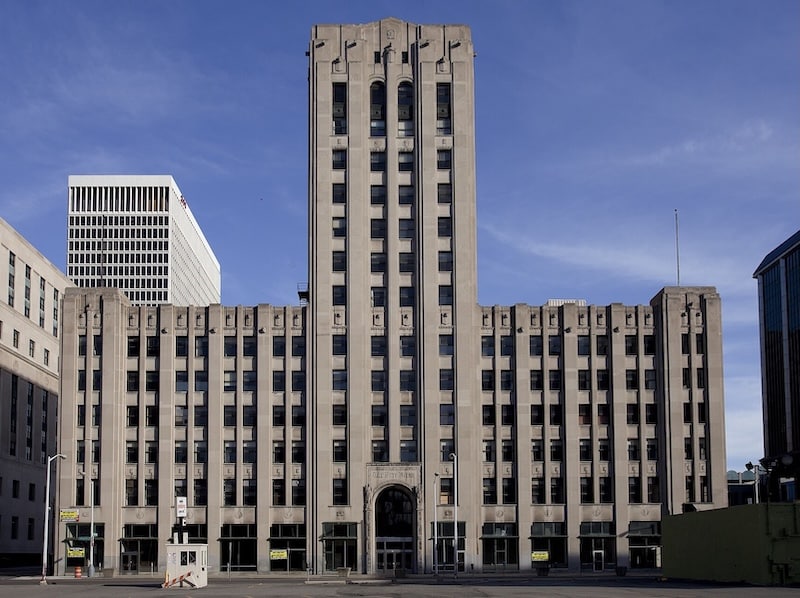Where Detroit’s Elite Meet for Eternity
Iron gates. Cold slabs of granite. Crinkling leaves. Tolling bells. Morbid, maybe. Creepy, sure. Still, a fall cemetery tour is a chance to commune with Detroit’s past, experience its present, and maybe even think about its future.
Most of Elmwood Cemetery looks like it’s straight out of a Bela Lugosi flick.
Aging tombstones, weather-beaten and blackened with age with barely legible markings stand not in neat rows but scattered in pockets throughout East Side burial ground. The wrought iron gates and stone facades of mausoleums dot hillsides, nearly hidden underneath the shady landscaping.
Across town at Woodlawn Cemetery on Woodward near Eight Mile, less ornate but nonetheless impressive marble and stone mausoleums bear the names of Detroit legends: Booth, Hudson, Groesbeck. And are those the Fords and the Dodges? Yes and yes.
Fall is here. The skies are gray more than blue. Halloween visions of ghost and goblins are dancing in our heads. What better time of year to take a walk in a graveyard – with only the sounds of crunching leaves under foot to break the silence of the place?
A cemetery tour can be creepy, kooky, mysterious and spooky, but it’s also a time capsule, a crash-course in hundreds of years of Detroit history.
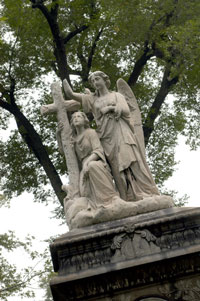 Chancey P. Miller, vice president of the Historic Elmwood Foundation and general manager of the cemetery, says cemeteries not only honor the dead, but they provide a record of other times and offer a personal and very tangible way to experience it. “It’s authentic history,” says Miller, and a trip to a cemetery “allows you to see it and touch it.”
Chancey P. Miller, vice president of the Historic Elmwood Foundation and general manager of the cemetery, says cemeteries not only honor the dead, but they provide a record of other times and offer a personal and very tangible way to experience it. “It’s authentic history,” says Miller, and a trip to a cemetery “allows you to see it and touch it.”
Elmwood: Jog through Detroit’s memories
Established in 1846, nondenominational Elmwood is very much a park — yes a park — but also a museum in which you can’t help but test your knowledge Motor City lore.
Nearby Mt. Elliot Cemetery, with it Catholic iconography adorning headstones more than a hundred years old, looks straight out of an episode of Buffy, but Elmwood is larger and has the ambiance of great urban cemetery, with some of the history and grandeur of Jim Morrison’s resting place, Cimetière du Père-Lachaise in Paris, mixed with a bit of the recreational feel of a place like Colonial Cemetery in Savannah, Ga., where locals like to take their dogs for a stroll or even picnic.
The recreation-friendly atmosphere, modeled after the European cemeteries of the time, was intentional, and is kept alive today by the joggers who come on their lunch breaks, and the track team from nearby Martin Luther King Jr. High School that practices there. Paths wind through the 86-acre cemetery, going up and down and around the hilly landscape. In the winter, when the pond freezes over, kids sometimes gather to play pickup hockey games there.
Miller says he welcomes the foot traffic to at Elmwood. “I figure, for every person who’s in the cemetery to do good, they’re probably preventing two from doing bad,” Miller says.
 Elmwood is the second-oldest cemetery in the city (nearby Mt. Elliot owns the title, having been founded in 1841), and is the final resting place for mayors and industrial leaders, architects and philanthropists, union bosses and war heroes.
Elmwood is the second-oldest cemetery in the city (nearby Mt. Elliot owns the title, having been founded in 1841), and is the final resting place for mayors and industrial leaders, architects and philanthropists, union bosses and war heroes.
Miller and his staff have loads of literature on hand about the cemetery, detailing the art and symbolism used in the headstones, a Black history tour and lists of senators, mayors and other notables buried there, as well as maps of the grounds. There is also a book, Elmwood Endures: History of a Detroit Cemetery, by Michael S. Franck, that details a lot of the lore, available for sale in the cemetery office.
Of course, wandering aimlessly without a map or guide is a fine way to explore, too. Elmwood has a lot to stumble on. New gravesites mix with ones that look ancient. Mayor Coleman Young is buried there, and so is Solomon S. Sibley, an attorney who became the city’s first mayor after being appointed by the territorial governor around 1806. There are also 26 other mayors, plus 11 U.S. senators, six governors, cabinet ministers and ambassadors.
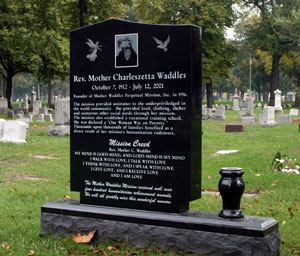 Other notables include Charleszetta “Mother” Waddles, Detroit’s famed champion of the poor, and brewery founder Bernhard Stroh. (They are resting for eternity just paces from each other — just think of the conversations they could be having!).
Other notables include Charleszetta “Mother” Waddles, Detroit’s famed champion of the poor, and brewery founder Bernhard Stroh. (They are resting for eternity just paces from each other — just think of the conversations they could be having!).
The smaller details are also fascinating.
The Victorians, always big on symbols, decorated tombstones with ornate designs, including certain telling flowers – lilies and roses to represent goodness and innocence, often for a child – or sheaves of wheat to represent a long life.
Even more unusual, though, are the stone tree trunks that dot the cemetery. The tree is symbolic of live, so the trunk or stump shaped headstones frequently symbolize a life cut down too soon.
And while Detroit’s well-known heroes are among those buried at Elmwood, some of its unsung heroes are there, too. The small, uniform markers of the city’s Civil War veterans are a reminder of how long Detroiters have been here. You get the same feeling when you pass the plot of firefighters graves — some dating back more than a hundred years, but all bearing the same symbols.
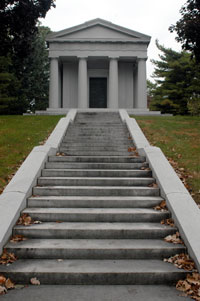 Woodlawn: Auto barons and architecture
Woodlawn: Auto barons and architecture
Woodlawn has a very different feel. It’s a study in architecture as much as it is a journey into Detroit’s great industrial past. Woodlawn’s greatest treasure is its hulking monuments and mausoleums that reflect the sleek, lines of art deco, curly cues of art nouveau, and grandness of Greek, Roman and Egyptian styles.
A walk through the grounds can be a solemn, reflective time, intensified by the quiet hum of the cars along Woodward and the occasional – and a bit ominous, truthfully – tolling of bells from a neighboring church.
Among Woodlawn’s most famous denizens are pioneers of the auto industry. Many of their mausoleums and tombs circle a reflecting pond in the center of the cemetery.
Edsel and Eleanor Ford’s graves are marked with an elegant, sleek black granite sarcophagus. (How’s this for creepy: William Clay Ford and wife Martha can visit their own grey granite sarcophagus right next door, with their names already etched in.)
A nearby row of mausoleums looks like the graveyard equivalent of a  suburban Christmas display – with each resident trying to outdo the next. The Dodge boys — Horace and John — are laid to rest inside what looks like an Egyptian tomb, complete with a pair of sphinxes standing guard.
suburban Christmas display – with each resident trying to outdo the next. The Dodge boys — Horace and John — are laid to rest inside what looks like an Egyptian tomb, complete with a pair of sphinxes standing guard.
Next door, stands Mathilda Dodge Wilson’s art deco mausoleum. It’s surprising that the one-time owner of Meadowbrook in Rochester would have such an elegant crypt. It’s a tall, very vertical structure with beautifully sculpted reliefs on the doors.
In addition to the auto magnates, other prolific Detroit innovators and industrialists rest in Woodlawn. C.J. Whitney’s domed, theatrical, art nouveau mausoleum is befitting a man who embraced the arts – owning a string of theaters, including the Detroit Opera House.
Some names have roots that go way back in Detroit history, but whose legacies today could be slipping. Onetime department store magnate J.L. Hudson is buried in Woodlawn, but with Hudson’s name changes and his old downtown store demolished, how soon before Detroit kids 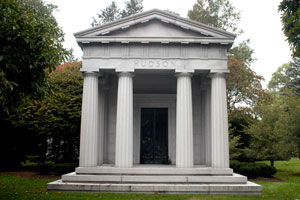 know nothing of his legacy? Or what about folks like Charles Bohn, an aviation technology pioneer; Clayton Grinnell, the musical instrument purveyor; or banker and politician Lawrence Snell? Their monuments may seem overly grand. Their histories are not insignificant, even if their names have been lost to many. But their stories are those of Detroit’s heydays, its boom times, the kind of glory days people are trying to recapture now. And with these monuments marking their graves, aren’t they insuring, in a way, that the city’s history won’t be easily forgotten? They’re not going anywhere, but where is Detroit headed?
know nothing of his legacy? Or what about folks like Charles Bohn, an aviation technology pioneer; Clayton Grinnell, the musical instrument purveyor; or banker and politician Lawrence Snell? Their monuments may seem overly grand. Their histories are not insignificant, even if their names have been lost to many. But their stories are those of Detroit’s heydays, its boom times, the kind of glory days people are trying to recapture now. And with these monuments marking their graves, aren’t they insuring, in a way, that the city’s history won’t be easily forgotten? They’re not going anywhere, but where is Detroit headed?
Martin Brosnan occasionally leads tours through Woodlawn, Elmwood and the city’s other historic cemeteries for the Detroit Historical Society. Learning about the lesser-known names in the city’s history is a wonderful part of a cemetery visit, he says.
Plus, it affords you a chance to think about how you will be remembered. What will be your mark on Detroit? Will it take a 10-foot-tall obelisk grave marker to remind people of it?
Deep thoughts, and Brosnan says that some people find it all too morbid. But for him, the deep thoughts are another reason to visit Woodlawn, Elmwood or any of the cities other historic cemeteries.
“To me, I find it psychologically very satisfying that you recognize that your time here is very short … so don’t get a big head about it.”
If you do, however, get a big head about it, and want a 10-foot obelisk marking your family’s burial plot, at either Elmwood or Woodlawn, you won’t be alone.
Links and other info:
Other burial plots of interest include Woodmere in Southwest Detroit, which opened in 1869, and the Ford Family cemetery at St. Martha’s Episcopal Church on the West Side.
A guide to more auto history rich cemeteries is at http://www.experienceeverythingautomotive.com/attractions.asp?cat=2
Elmwood Cemetery:
http://elmwoodhistoriccemetery.org
Detroit Historical Society, which offers occasional tours of Detroit cemeteries:
http://www.detroithistorical.org/
Woodlawn:
A great guidebook for Woodlawn is historian A. Dale Northup’s book, Detroit’s Woodlawn Cemetery, published by Arcadia Publishing in 2003.
